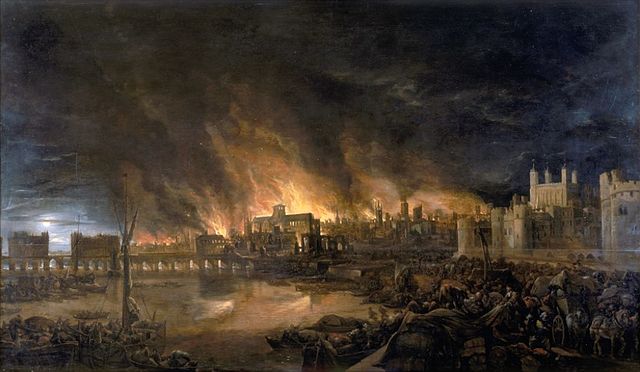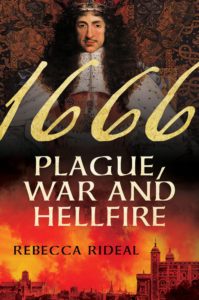by Rebecca Rideal
As the sun set on another hot day, an easterly wind danced through the capital, weaving its way westward. From Islington, Samuel Pepys and his wife journeyed home after watching a new puppet show on Moorfields before sharing food and wine with their friends, Mary Mercer and Sir William Penn. The Pepyses could have traveled any number of ways home, but the quickest route was to head south in their coach towards the scaffolding heavy St Paul’s Cathedral, before turning east along the historic throughway and marketplace of Cheapside, following the road through to Lombard Street and then Eastcheap, before finally reaching their home in Seething Lane.

If they had taken this particular route, Thomas Farriner might just have heard the ‘mighty merry’ pair singing cheerfully as their coach skimmed past Pudding Lane. Thomas Farriner’s working day was drawing to a close and at 10 p.m. he raked through the coals in the oven of his bake-house to subdue the tired fire.
Thomas Farriner awakes to choking smoke
This evening Thomas Farriner kept company with his daughter Hanna, his apprentice son Thomas Farriner, and their maid. At around midnight, his daughter went downstairs to the bake-house to get a light for a candle. There may or may not have been timber for the following week drying close to, or perhaps inside, the oven. In any case, it was later claimed that there hadn’t been enough fire in the oven to light the candle so a flame was found elsewhere. Soon afterwards, the family, like the rest of London, was asleep.
Between 1 a.m. and 2 a.m., at roughly the same time the fleet had sighted the Dungeness Lighthouse, the Farriner family awoke choking; smoke was filling their living quarters. It seemed that a fire had started in their bake-house and the blaze had become so well established that thick fumes and orange heat roared up the stairs of their ramshackle house. With their main exit blocked, the only means of escape was through a window and over the roof. Thomas Farriner and his adult son and teenage daughter climbed out to save themselves; his daughter scorched her skin a little during their escape. Too fearful to follow, their maid remained behind and perished in the flames. As they scrambled to safety, the bundles of faggots stored in Thomas Farriner’s yard quickly caught alight and the blaze began to spread to the adjacent houses.
Attempts to quickly extinguish the fire fail
‘Fire! Fire! Fire!’ was shouted out in the surrounding streets as neighboring citizens woke from their sleep, looked out of their windows, dressed and ran to see what the commotion was all about. With the alarm raised, the city watchmen alerted the mayor, Thomas Bludworth, who quickly arrived on the scene. London knew fires; they happened frequently with varying severity. As such, there were procedures in place to deal with blazes which, when coupled with human instinct (i.e. it not being wise to stay in a burning building), were usually successful.
First, water pipes, which ran under the pavement, were severed to fill and refill leather fire-buckets – some brave souls even attempted to use ladders to tackle the flames from above. Fire engines, which worked by pumping water through a squirt, were sent for but found to be too cumbersome to navigate the maze of narrow alleys in and around Pudding Lane. One of the most effective procedures was the rather rudimentary practice of pulling down surrounding buildings to create a firebreak.
The fire spreads down Pudding Lane
Seeing how rapidly the fire was spreading down Pudding Lane, this was suggested to Bludworth by some seamen who were helping to fight the fire. They pressed upon him the need to act fast, but the Lord Mayor was acutely aware of the financial demands that would be leveled at him should properties be unlawfully demolished. He reportedly told the seamen that ‘he durst not do it without the consent of the owners’. However, the majority of Thomas Farriner’s neighbours were tenants rather than owners and could not offer the permission Bludworth required. Confused by the speed of the destruction, they looked to save themselves and their goods instead of, what the official report would later claim, ‘preventing the further delusion of it, by pulling down houses as ought to have been’. With, as the puritan preacher Thomas Vincent put it, ‘neither brains nor hands to prevent its ruin’, in a very short time, the furious fire became too big to control.

Samuel Pepys awakes to ‘a great fire in the city’
By 3 a.m., Pepys was awoken by his maids. They told him of a ‘great fire they saw in the City’. Putting on his nightgown, he looked out of the window and saw a fire several streets away. Judging it to be some distance from his house, he went back to sleep. While he slumbered, the fire traveled south down Fish Hill towards the River Thames – like lava, it claimed everything in its path.
By the time dawn arrived, the ancient church of St Magnus the Martyr, a place that should have been being preparing for the day’s sermons, had become the fire’s first ecclesiastical victim; its windows cracked and its stones disintegrated. The furious river wind nudged the flames towards the commodity rich Thames Street.
REBECCA RIDEAL is a writer and television producer who contributed to such documentaries as: Bloody Tales of the Tower, Adventurer’s Guide to Britain, Jack the Ripper: Killer Revealed, Escape from a Nazi Death Camp, and the triple Emmy award winning series David Attenborough’s First Life. She currently runs the online magazine The History Vault and is studying for a PhD on Restoration London at University College in London. She is the author of 1666: PLAGUE, WAR, AND HELLFIRE.

